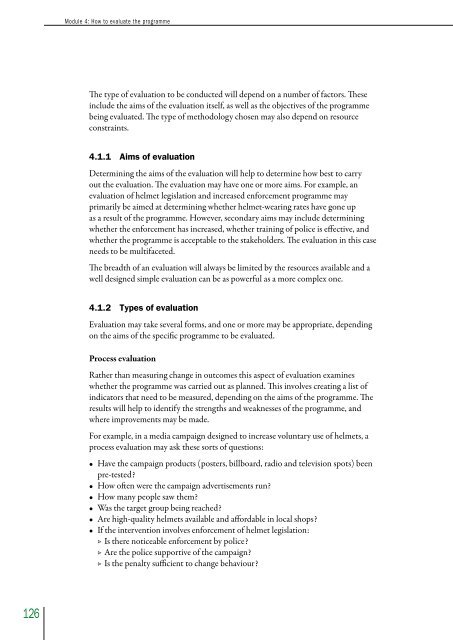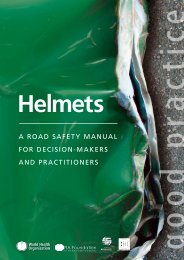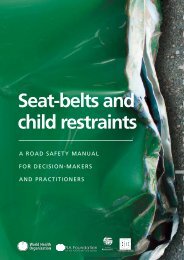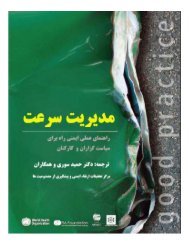How to evaluate the programme - World Health Organization
How to evaluate the programme - World Health Organization
How to evaluate the programme - World Health Organization
Create successful ePaper yourself
Turn your PDF publications into a flip-book with our unique Google optimized e-Paper software.
Module 4: <strong>How</strong> <strong>to</strong> <strong>evaluate</strong> <strong>the</strong> <strong>programme</strong><br />
The type of evaluation <strong>to</strong> be conducted will depend on a number of fac<strong>to</strong>rs. These<br />
include <strong>the</strong> aims of <strong>the</strong> evaluation itself, as well as <strong>the</strong> objectives of <strong>the</strong> <strong>programme</strong><br />
being <strong>evaluate</strong>d. The type of methodology chosen may also depend on resource<br />
constraints.<br />
4.1.1 Aims of evaluation<br />
Determining <strong>the</strong> aims of <strong>the</strong> evaluation will help <strong>to</strong> determine how best <strong>to</strong> carry<br />
out <strong>the</strong> evaluation. The evaluation may have one or more aims. For example, an<br />
evaluation of helmet legislation and increased enforcement <strong>programme</strong> may<br />
primarily be aimed at determining whe<strong>the</strong>r helmet-wearing rates have gone up<br />
as a result of <strong>the</strong> <strong>programme</strong>. <strong>How</strong>ever, secondary aims may include determining<br />
whe<strong>the</strong>r <strong>the</strong> enforcement has increased, whe<strong>the</strong>r training of police is effective, and<br />
whe<strong>the</strong>r <strong>the</strong> <strong>programme</strong> is acceptable <strong>to</strong> <strong>the</strong> stakeholders. The evaluation in this case<br />
needs <strong>to</strong> be multifaceted.<br />
The breadth of an evaluation will always be limited by <strong>the</strong> resources available and a<br />
well designed simple evaluation can be as powerful as a more complex one.<br />
4.1.2 Types of evaluation<br />
Evaluation may take several forms, and one or more may be appropriate, depending<br />
on <strong>the</strong> aims of <strong>the</strong> specific <strong>programme</strong> <strong>to</strong> be <strong>evaluate</strong>d.<br />
Process evaluation<br />
Ra<strong>the</strong>r than measuring change in outcomes this aspect of evaluation examines<br />
whe<strong>the</strong>r <strong>the</strong> <strong>programme</strong> was carried out as planned. This involves creating a list of<br />
indica<strong>to</strong>rs that need <strong>to</strong> be measured, depending on <strong>the</strong> aims of <strong>the</strong> <strong>programme</strong>. The<br />
results will help <strong>to</strong> identify <strong>the</strong> strengths and weaknesses of <strong>the</strong> <strong>programme</strong>, and<br />
where improvements may be made.<br />
For example, in a media campaign designed <strong>to</strong> increase voluntary use of helmets, a<br />
process evaluation may ask <strong>the</strong>se sorts of questions:<br />
•<br />
•<br />
•<br />
•<br />
•<br />
•<br />
Have <strong>the</strong> campaign products (posters, billboard, radio and television spots) been<br />
pre-tested<br />
<strong>How</strong> often were <strong>the</strong> campaign advertisements run<br />
<strong>How</strong> many people saw <strong>the</strong>m<br />
Was <strong>the</strong> target group being reached<br />
Are high-quality helmets available and affordable in local shops<br />
If <strong>the</strong> intervention involves enforcement of helmet legislation:<br />
▷<br />
▷<br />
▷<br />
Is <strong>the</strong>re noticeable enforcement by police<br />
Are <strong>the</strong> police supportive of <strong>the</strong> campaign<br />
Is <strong>the</strong> penalty sufficient <strong>to</strong> change behaviour<br />
126

















